Wonderboy: The life, loves and death of Eric Emerson by Gary Comenas
The Mercer Arts Center was described in a 1971 article in the New York Times in the following way:
McCandlish Phillips ("Mercer Stages Are a Supermarket," New York Times, November 2, 1971):
In Greenwich Village, hard by a row of shipping-receiving platforms, there is one small door that leads to five Off-Broadway theaters A flag over the entrance marks the Mercer Arts Center - a family of theaters under one roof that, until very recently leaked... The center's theaters are off Broadway, in the narrow sense, since the back door to all five is on Broadway. The front door door is at 240 Mercer Street.
The earliest documentary evidence I have found of The Magic Tramps performing at the Mercer Arts Center is a May 1972 schedule that appears in the archives of the vasulka.org website here. "The Kitchen," as per the bottom of the image, was operating out of the Mercer Arts Center at the time. (See Vasulka documents for more documents regarding The Kitchen during 1971 - 1973.)
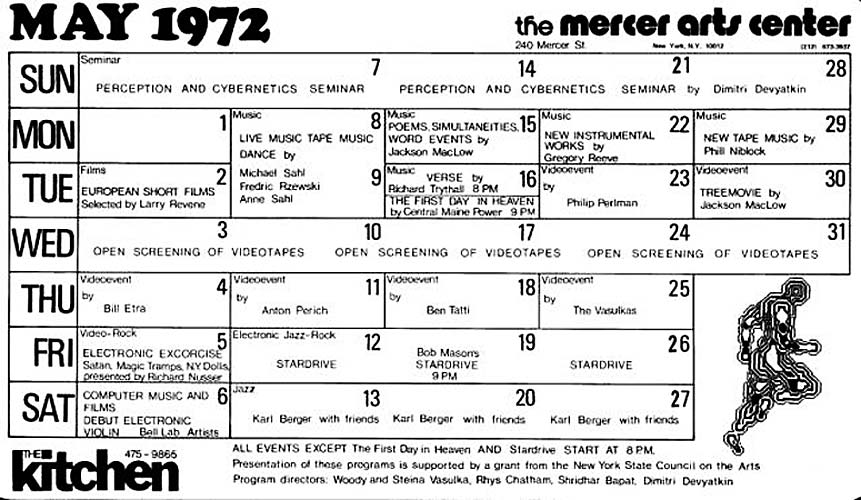
There are also a number of flyers relating to the Mercer Arts Center (and to Max's Kansas City) on the Magic Tramps website, but the years of the flyers are not indicated. In the above schedule, The Tramps are listed on May 5th - after "Satan" and before the N.Y. Dolls. David Johansen, the lead singer of the Dolls remembers being asked to support Eric and the Magic Tramps at the venue:
David Johansen:
Eric Emerson had a band called the Magic Tramps and he said to me one day, "You know I'm playing at this place, the Mercer Arts Center. Do you want to open for us?" And, I was like, "Yeah." We would play anywhere, 'cause we didn't have anyplace to go, really. So we went and played for him, and then people liked us a lot... and then they offered us a night of our own every week in the Oscar Wilde Room. (RTD247)
Chris Stein went to the venue to see the Dolls and ended up befriending Eric.
Chris Stein:
I was in art school. I was at the School of Visual Arts and I used to think that the Dolls were a drag act so I never went to the see the Dolls. When I finally found out they were a rock band, I went to see them and Eric was playing with them. He opened up for them and I kind of liked him more. I got friendly with Eric and my last year at Visual Arts I got them to play at the school party. (HRK3815)
Stein became Eric's roadie and "intermittent bass and guitar" player and Eric moved into Chris's apartment on First Avenue and First Street." (PL816) It was Stein's first apartment. He had got it "like 1969 or 1970." (PL637) Debbie Harry also went to the Mercer although it wasn't until the following year that she met Chris. (PL824)
The first Village Voice ad that mentions Eric performing at the Mercer Arts Center was in the May 18, 1972 issue. The ad only mentions Eric but presumably the Magic Tramps musicians were backing him.
The ad for the Mercer Arts Center took up a whole column of the left side of the page of the Voice, which listed the different venues at the arts centre.
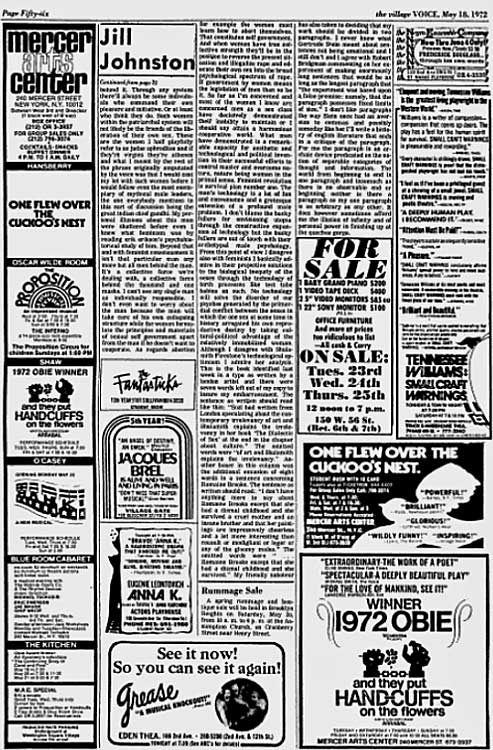
Village Voice ad May 18, 1972
A close up of the section of the same ad with Eric's name listed in the centre's "Blue Room Cabaret:"
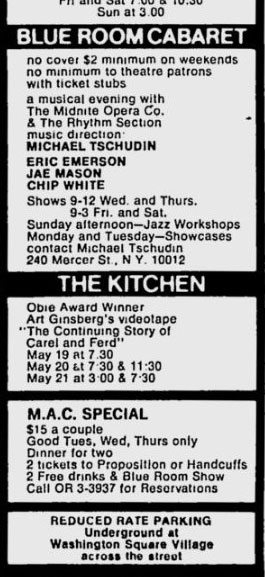
Village Voice, May 18, 1972
Eric's name also appeared without The Magic Tramps in the June 1, 1972 issue of the Voice:
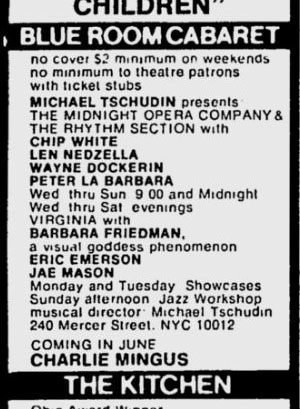
Village Voice ad, June 1, 1972
On June 8 Eric was billed with the Magic Tramps:
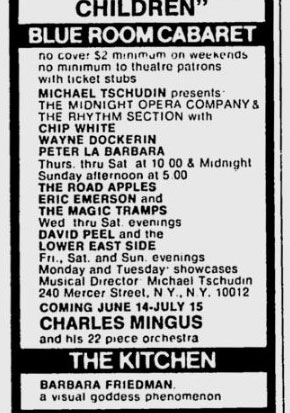
Village Voice ad, June 8, 1972
Although the June 8th ad suggests that "Eric Emerson and The Magic Tramps" are going to perform "Wed thru Sat. evenings," they were not mentioned in the Blue Room ad after the June 8th issue. Charles Mingus was advertised in the Blue Room for the ads in the June 15th, 22nd, 29th and July 6th issues of the Voice, followed by the Midnight Opera Company in the July 13th ad.
According to the "This Aint the Summer of Love" website, "On June 13, 1972, the Dolls began 17 straight Tuesdays in the 200-capacity Oscar Wilde Room, supporting Satan the Fire Eater and the Magic Tramps which included late singer Eric Emerson (who's death [in 1975] inspired Lou Reed's 'Street Hassle') and future Blondie guitarist Chris Stein." But the N.Y. Dolls lead singer, David Johansen, said in the quote above that the Dolls were offered "a night of our own" at the Oscar Wilde Room. The Tramps were not mentioned in the advertising in the Village Voice so if they did perform with the Dolls during this period, it was probably as the support band - if they performed at all. The ads also show that the Dolls played in the Oscar Wilde Room for five Tuesdays rather than 17.
The first ad for the Dolls was in the June 15, 1972 issue of the Voice and the last ad for the Dolls was in the July 13th issue.

Village Voice ads (1972) L to R: June 15, June 22, June 29, July 6, July 13 and July 20 (when the Dolls are no longer playing)
The Dolls are referred to as "The Dolls of New York" in the ads and, as mentioned previously, there is no mention of Eric or the Tramps in the ads.
In August 1972, Ira Mayer noted in the "riffs" column of the Village Voice the demise of "patrons of the Eric Emerson Review" at Max's:
Ira Mayer ("Riffs," Village Voice, August 17, 1972, p. 34):
With what appears to be the final and absolute closing of the MacDougal Street Gaslight, there is no real "listening" room left in New York... The closest is the room at Max's, which has gotten to where it is, not coincidentally, under the tutelage of Sam Hood, who used to run the Gaslight... At Max's the sound system, from out front, is excellent... the help is generally courteous and easy going (here with the exception of one waiter who doesn't seem to have realized that he's not serving patrons of the Eric Emerson Review anymore); and Hood has managed to weed out some of the stranger characters who have made the downstairs restaurant their home. Also, before sets he usually politely and not condescendingly requests that the audience hold their conversation until after the show.
The era of Warhol and his crowd hanging out at Max's was more or less over. Now Max's was a music venue that catered mostly to straight bands. When Holly Woodlawn launched her cabaret act the following year, she didn't play Max's. She played Reno Sweeney.
In September, 1972 Eric and The Magic Tramps were the first band to play at the newly opened Popcorn Pub in Queens. It wasn't a particularly good review for Eric. The reviewer writes, "Even Emerson's balletic leaps and pirouettes across the stage and dance floor... seemed uninspired."
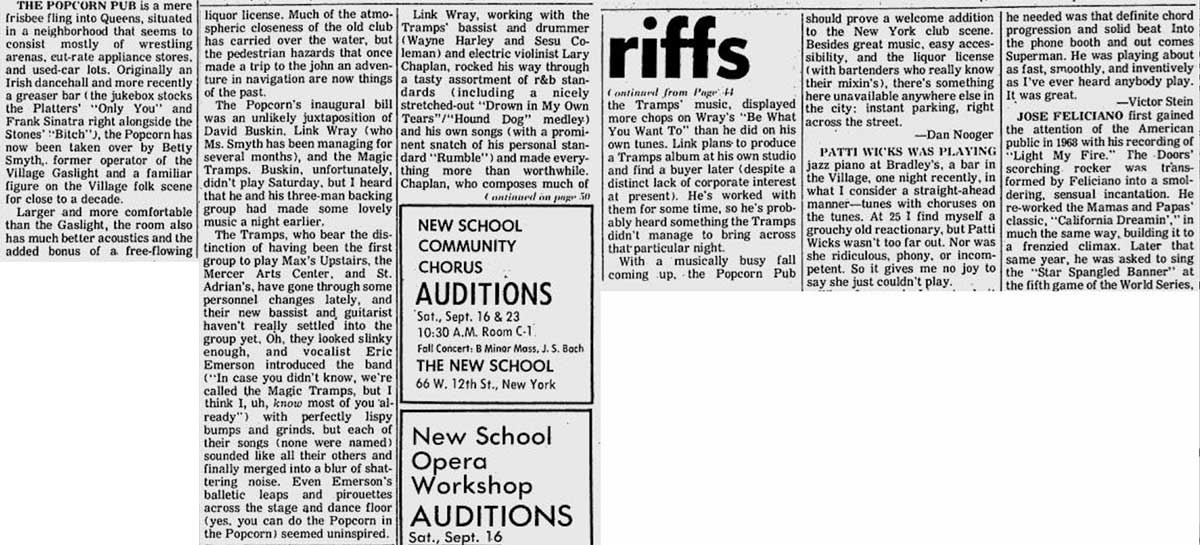
Village Voice, September 14, 1972
In October 19, 1972, The Magic Tramps and Eric played at Hilly's on the Bowery which would, in December, become CBGB.:
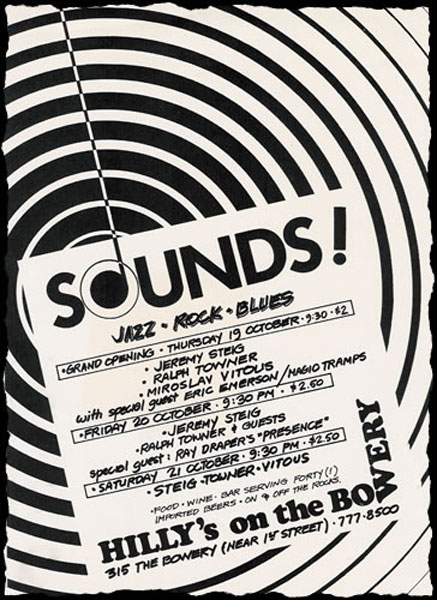
Flyer for Eric Emerson/Magic Tramps at Hilly's on the Bowery, October 19, 1972
(This Aint the Summer of Love blogspot)
At the end of the year "Eric Emerson and The Magic Tramps" played at a New Year's party at the Mercer. They were billed third, after the headlining act, the New York Dolls, and Ruby Lynn Reyner's band, Ruby and the Red Necks:
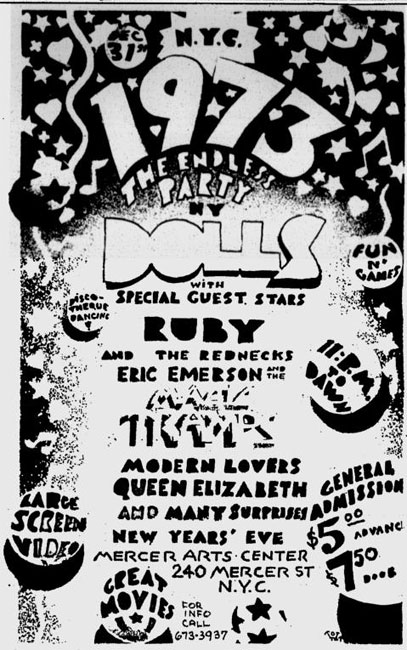
Village Voice ad, December 28, 1972
The gig was also mentioned in the Mercer's usual full column ad in the Voice, with "Queen Elizabeth with Wayne County" on the bill.
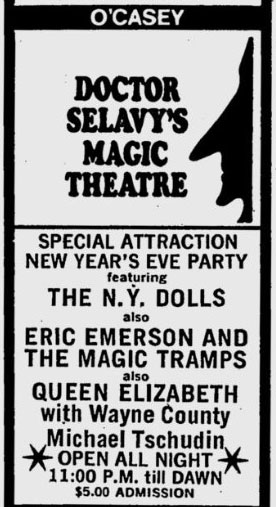
Village Voice ad, December 28, 1972, p. 42
The O'Casey was one of the venues of the Mercer Arts Center. The following year the Mercer Arts Center would collapse and so would Eric's career.